 ADDICTS
ADDICTSThe myth of the hands of clay
Jean Levi __ May 03, 2012
"The Terracotta Army is a FAKE"
Interview with JEAN LEVI
sinologist, translator, writer, research director at CNRS
by Alessandro Mercuri
<> PDF
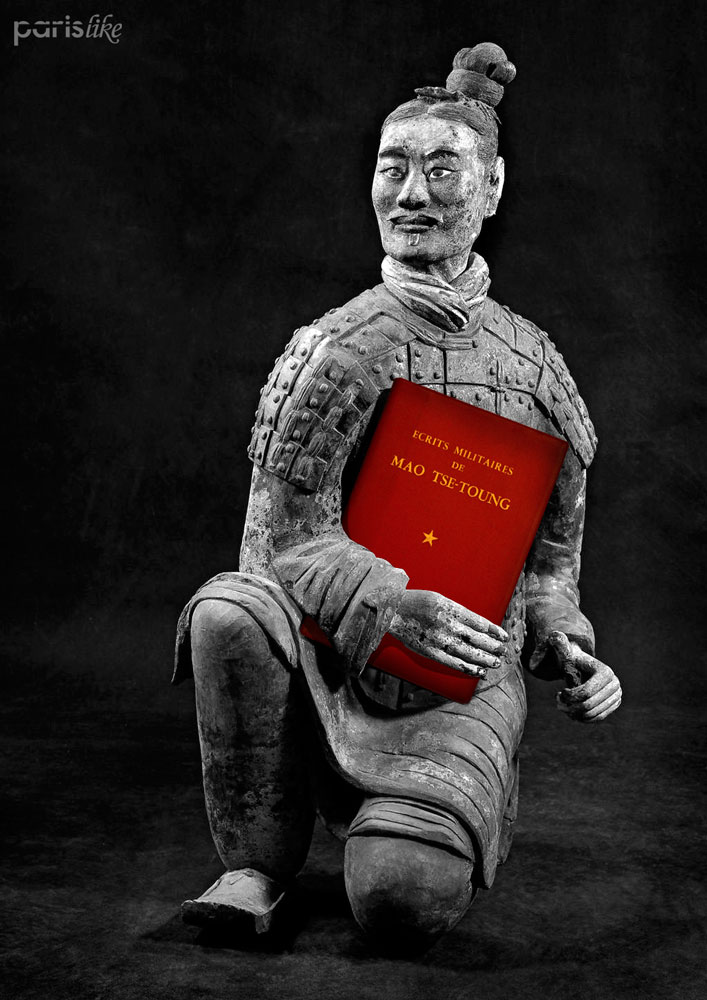

Alessandro Mercuri : In the first chapter of your book "China is a Horse and the Universe an Idea" (La Chine est un cheval et l'univers une idée, Editions Maurice Nadeau, 2010), entitled “The Great Emperor and the terra-cotta warriors”, you develop a very unsettling and amazing idea which is at first difficult to believe as your hypothesis completely negates the authenticity of one of the most famous “new wonders of the world”, inscribed on the World Heritage List of the UNESCO in 1987. According to you, the famous terracotta warriors of the Emperor Qin Shi Huang’s mausoleum are fake. It could be one of the most incredible historical forgeries, hoaxes or deceptions. The statues currently exhibited on the archeological site of the mausoleum would not date back from the 3rd century B.C. but from the 1970s. They may not have been made under the reign of the Great Emperor Qin Shi Huang, but under the Great Helmsman, Mao Zedong, at the very end of his reign and of the Cultural Revolution, in 1974, that is to say two years before his death. How have you come up with this surprising hypothesis? What could be the archeological, historical and aesthetical characteristics of these fake figures? Could it be a true Maoist deception?
Jean Levi : In “The Great Emperor and the terracotta warriors” (the first chapter of my book of essays China is a Horse and the Universe an idea) I do maintain the theory that the gigantic terra-cotta statues excavated in the pits surrounding the tumulus of the First Emperor are fake. These famous clay sentinels, which protect the sleep of the despot eternally as is insistently and pompously proclaimed by journalists, do not date back from the 3rd century B.C., the time when the Great Emperor was buried, but from the 20th century, at the end of the Cultural Revolution when the struggle between factions was raging with the “Gang of Four”. As you’ve pointed out, it is nonetheless surprising that this “new wonder of the world”, which has crowds from the four corners of the planet gape with admiration, was inscribed on the World Heritage List without being assessed by international experts as is usually the case when a country officially asks for an artistic or architectural place or property to be listed. The Chinese authorities purely and simply refused the UNESCO experts access to the archeological site, although those same experts apparently did not take much offence as Lingtong’s buried army was added to the list anyway.
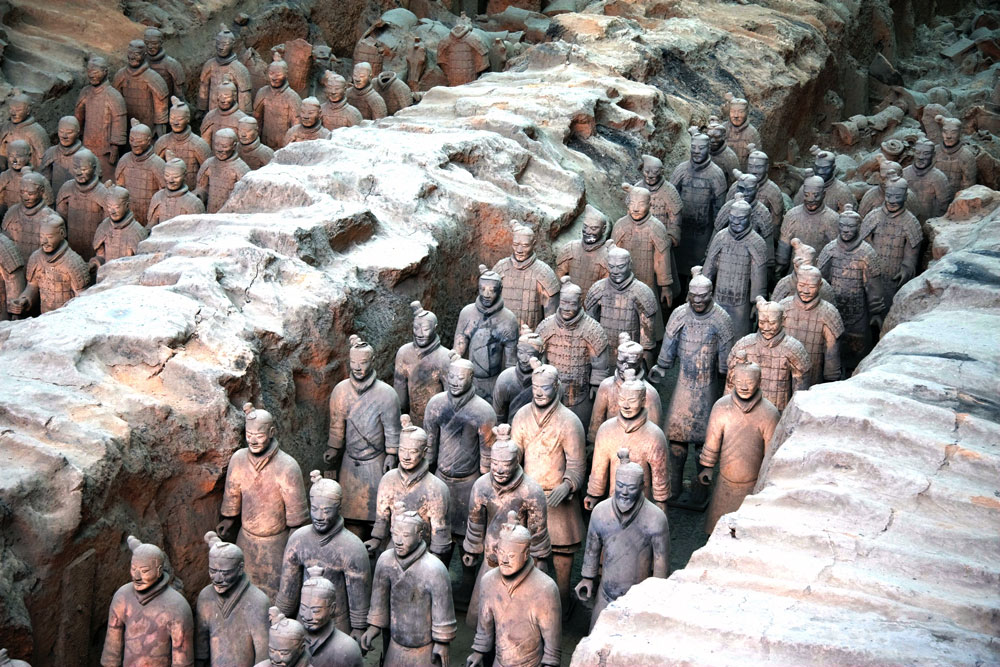
Mausoleum of Emperor Qin Shi Huang
I wish to insist on the fact that I’m neither an archeologist nor a specialist of ancient Chinese statuary; I have never had any privileged access to the statues and I have not carried out any physical and chemical laboratory test. My judgment is based purely on stylistic and aesthetic criteria. If we look in detail at the evolution of the manufacturing of funerary terracotta statuary — as a great number of such objects have come down to us — it is obvious that the statues of these warriors are in sharp contrast to everything that preceded and followed them. They stand out because of their gigantic size, their realism and the expressivity of their body language and of their faces. From the Warring States era (5th-3rd centuries B.C.) to the Tang era (7th-9th century A.D.), funerary statuettes are recognizable by their reduced size, their stylization, their hieratic quality and the sobriety of the techniques used. The mingqi — the artifacts made with the specific purpose to accompany the dead in the world beyond — are stylized and refined representations of the real objects; they must not be lifelike copies of reality at all — so as not to confuse the dead with the living. We could put forward the fact that the Great Emperor, who innovated politically by suppressing the feudal system and its fiefs and by establishing the first centralized and bureaucratic government, also tried to break with traditions in the artistic fields in the same way that he had done politically and ideologically.
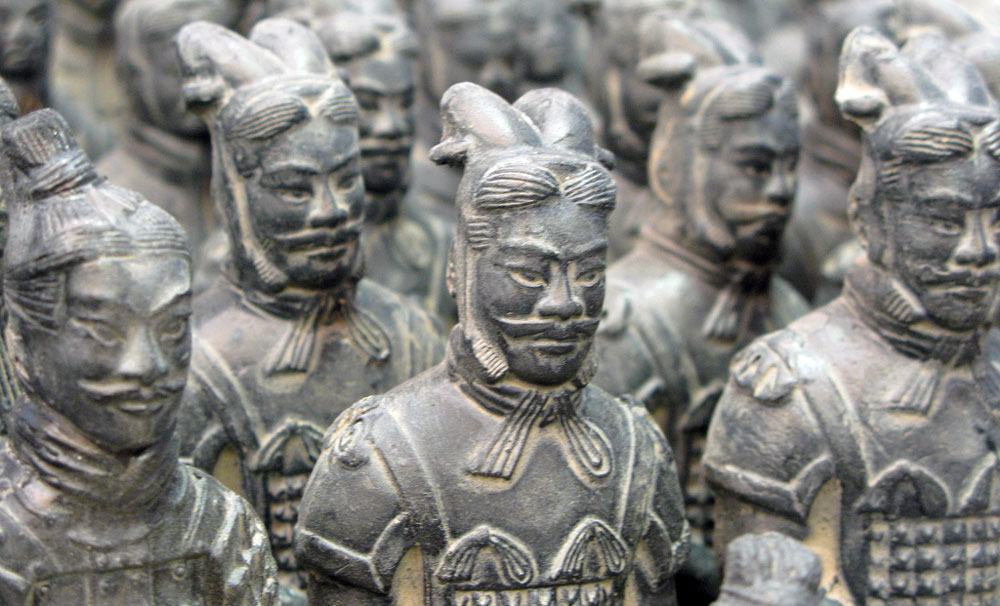
Mausoleum of Emperor Qin Shi Huang

Statue of Emperor Qin Shi Huang (copy) - product available on China Trade Online - Price Terms : Negotiable
But in fact, all the studies show that the Qin dynasty, although innovative as far as political institutions were concerned, remained conservative in other fields, especially in the artistic ones. Besides, the autocratic reign of Qin Shi Huang was brief — for many years, he was under the tutelage of the Empress dowager and of the Prime Minister Lü Buwei. Now the funerary contents of a grave must be prepared long ahead, and craftsmen, artists and technicians cannot be trained instantaneously to produce a new style. Consequently, it seems rather strange that this terracotta army could have been made in so little time. Moreover, with their monumentality, their realistic aspect and their expressivity, the statues have obvious similarities with the artifacts of socialist realism; all the more bizarre, nothing probably remained of the architectural achievements of the hated emperor after the sacking of the capital of the Qin dynasty by the rebel armies: we are thus entitled to question the authenticity of these statues exhumed from the ground as intact and as clean as a new coin. It is really surprising that not one specialist of this period has expressed doubts or concerns about them. On the contrary, the approval was unanimous.

Mausoleum of Emperor Qin Shi Huang
Apart from the unilateral argument which states that the unanimity of the specialists to consider the terracotta warriors as authentic is the irrefutable proof of their authenticity, the few archeologists I could discuss this issue with resort to two types of argument. The first one is technical: it is about the difficulty that would arise from having armies of modern workers create funerary statues without any leak of their production occurring. Were the workers disposed of? And how? The second objection is political: it refers to the ideological and strategic motives of falsification.
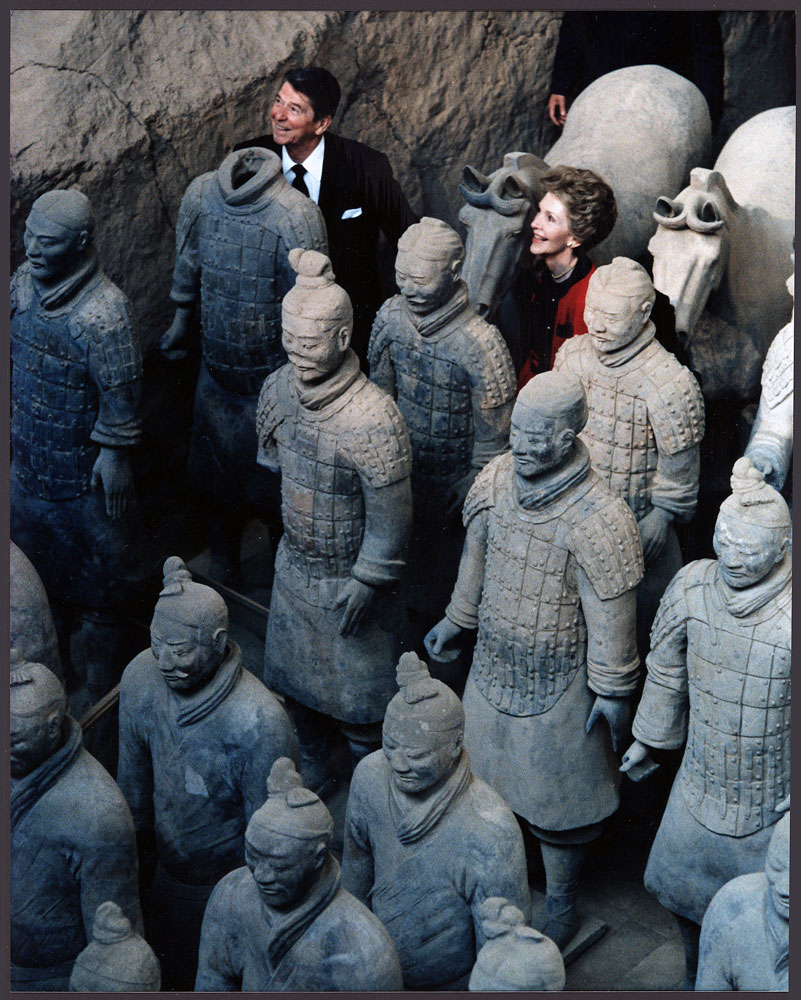
Ronald and Nancy Reagan at the Mausoleum of Emperor Qin Shi Huang (1984)
The first objection does not hold. Nothing is simpler than having life-size terracotta statues manufactured in state workshops while pretending it is an activity of copying, as is done in every museum and archeological site on the planet. Except that they are not copies but fake original works. Nonetheless, given the nature of the regime, there was no difficulty involved for the Beijing authorities — nor would there be any nowadays either — to dispose of a few thousand workers and technicians. As for the instigators of the project, it was in their best interest to keep it secret.
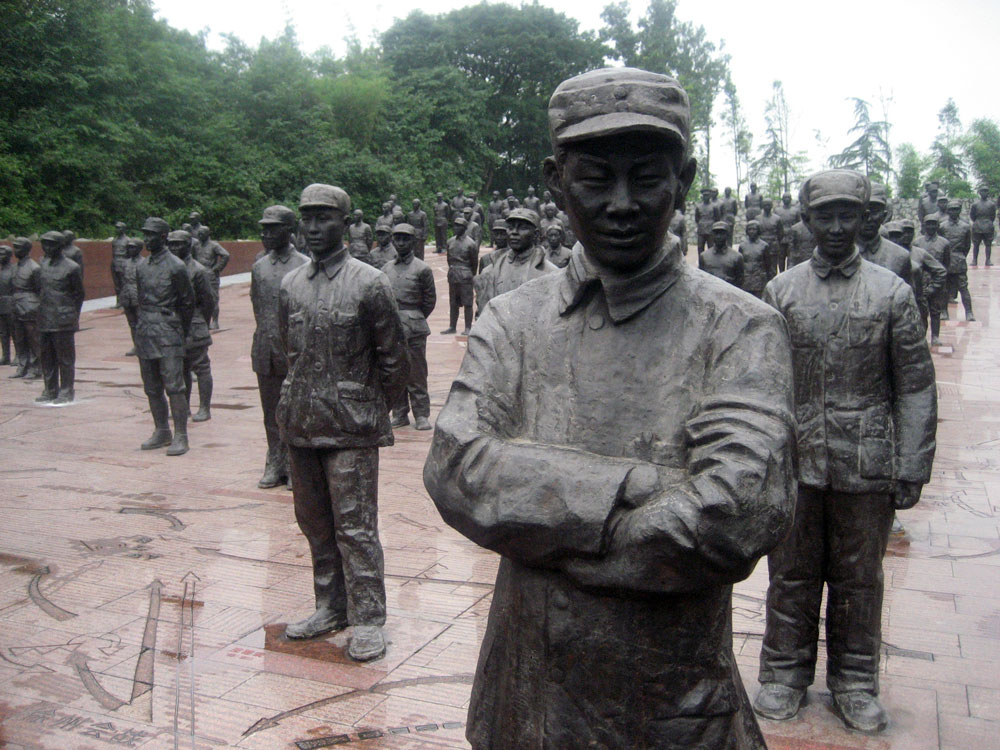
Statues of Chinese soldiers, Jianchuan Museum, picture by Alan Baumler
As for the second objection, which concerns the absurdity and the vanity of the enterprise, it is necessary to remember the ideological context of the Maoist period. The cult of personality had reached its climax. They would have stopped at nothing to glorify the figure of the Great Helmsman; as Mao Zedong tended to increasingly identify himself with the figure of the First Emperor, the discovery around Qin Shi Huang’s mausoleum of a grandiose army of terracotta giants was equivalent to singing an hymn to Mao’s glory and reinforced his grandeur by proxy. This “discovery” may also have met strategic necessities in a balance of power. It was a response to the archeological discovery of Mawangdui. In 1972, in Hunan, a numerous manuscripts written on silk, along with a shroud of jade plaques sewn together with gold threads and other incredibly refined objects, were excavated in a royal tomb dating back from the early Han Dynasty. Among the manuscripts, there were syncretic texts which merged different schools of thought: that of the doctrinarian legalists, Taoism and some aspects of the Confucian doctrine. In Mao’s China, where political struggles were disguised behind the masks of historical figures, the dogmatic adversaries thus saw in this discovery a worrying signal, that of a right-wing shift on the part of the pragmatic wing of the bureaucracy, whose leader was Zhou Enlai. The incredible discovery of the terracotta warriors of the Chinese despotic unifier, which put the spotlight on his prodigious technical and artistic achievements, helped remind everyone of the preeminence of the guiding force of the regime, underlined the necessity to strengthen the dictatorship of the proletariat and showed a determination to take control of things again ideologically.
It goes without saying that nothing is left of these original preoccupations nowadays; how is this for historical irony? The mausoleum hereby asserts the power of China through its patrimonial grandeur. The immemorial and glorious past, to which the terracotta army is testimony, is like a bill drawn on the future. It substantiates the Chinese claim to worldwide hegemony. And naturally, along with the mercantile insanity which has grabbed hold of Chinese society, the terracotta army has become an important source of income and provides a living for an army of parasites from all walks of life.
Besides, the point of my essay was not to dwell on the motives of the Maoist bureaucracy when they devised the extravagant project to fill the mausoleum of the historical double of the Great Helmsman with droves of terracotta figures, but to study the phenomenon of the contemporary masses’ admiration for ugliness, and the impossibility for the modern world to make the difference between reality and its imitations.
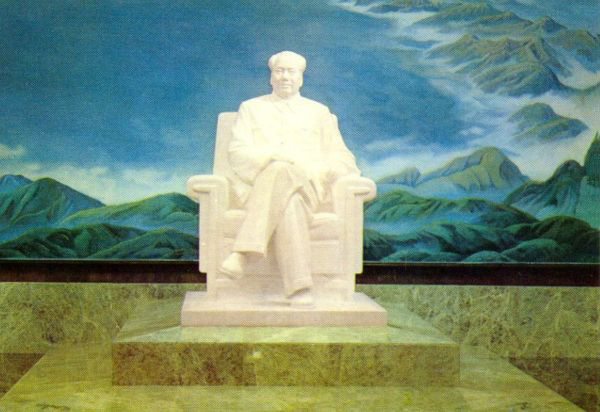
Statue of Mao Zedong, Mausoleum of Mao Zedong
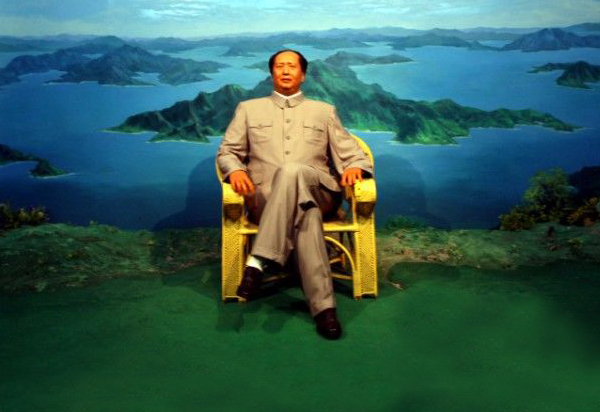
Wax statue of Mao Zedong
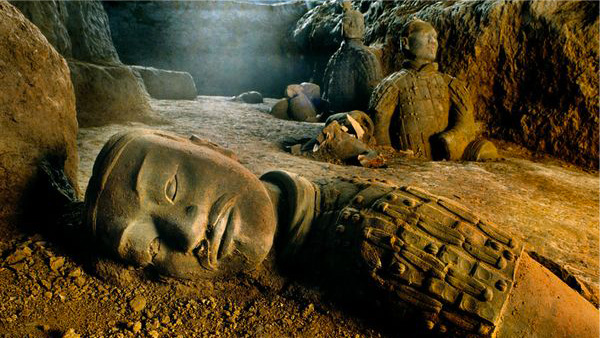
Mausoleum of Emperor Qin Shi Huang
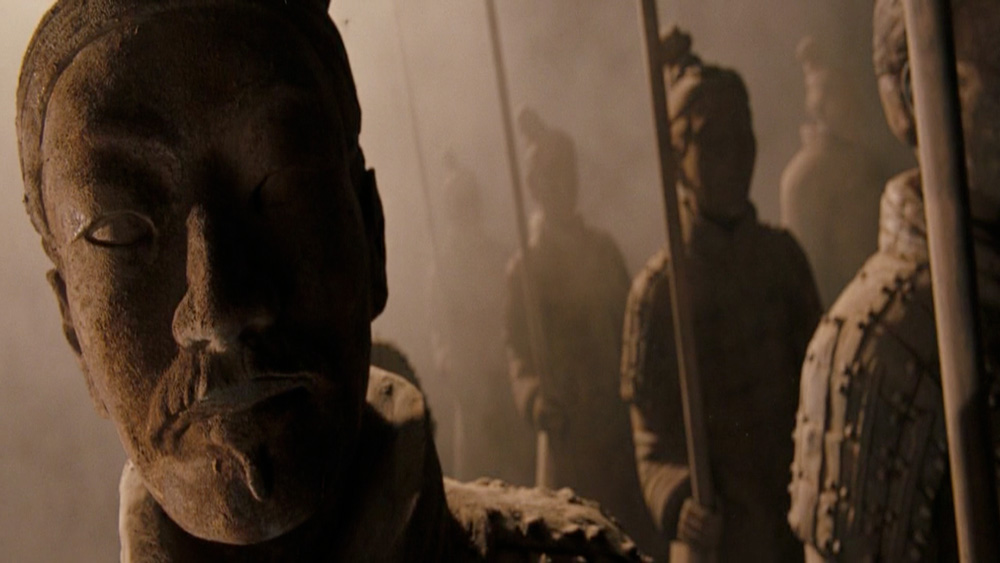
The Mummy: Tomb of the Dragon Emperor (2008), directed by Rob Cohen
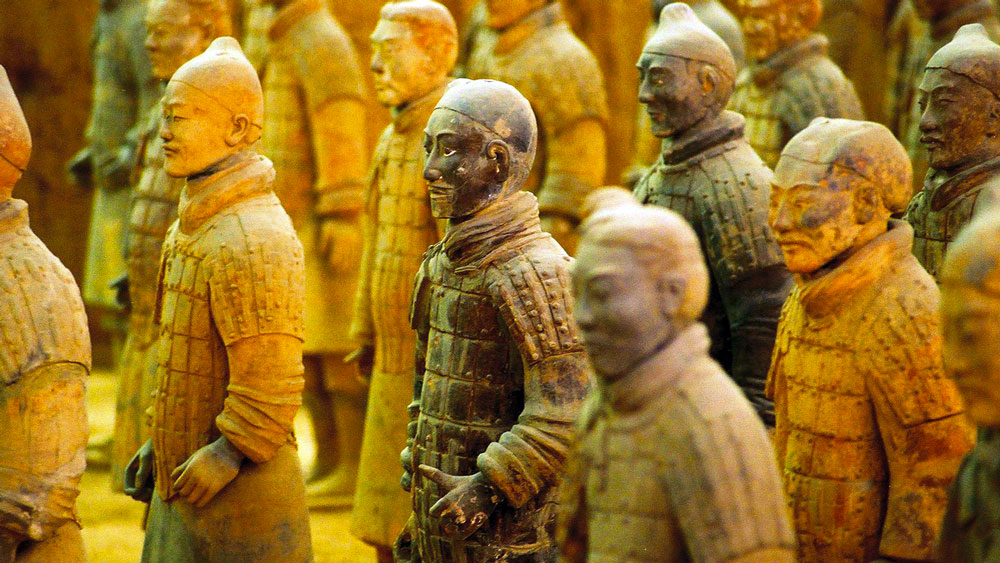
Mausoleum of Emperor Qin Shi Huang

The Mummy: Tomb of the Dragon Emperor (2008), directed by Rob Cohen

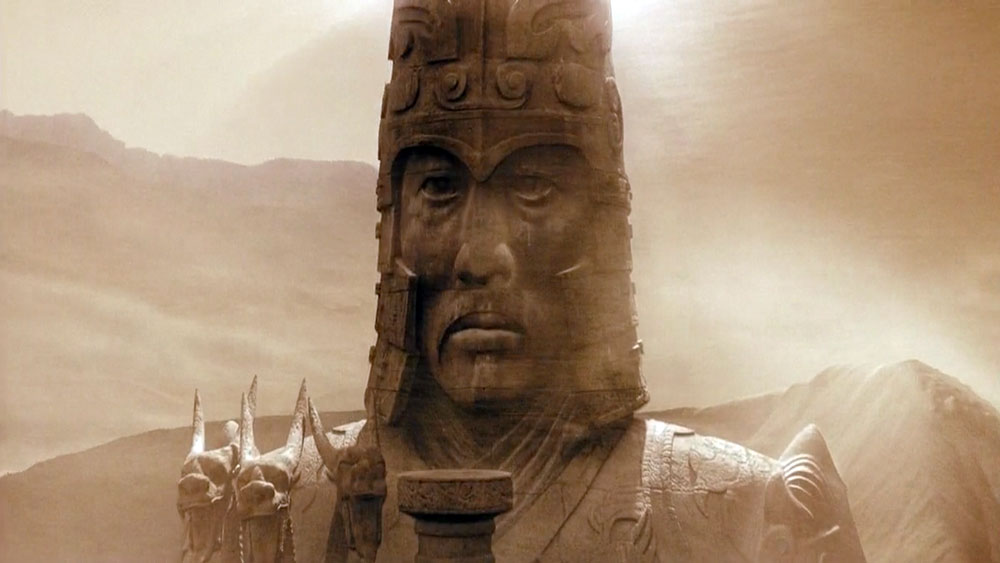
The Mummy: Tomb of the Dragon Emperor (2008), directed by Rob Cohen
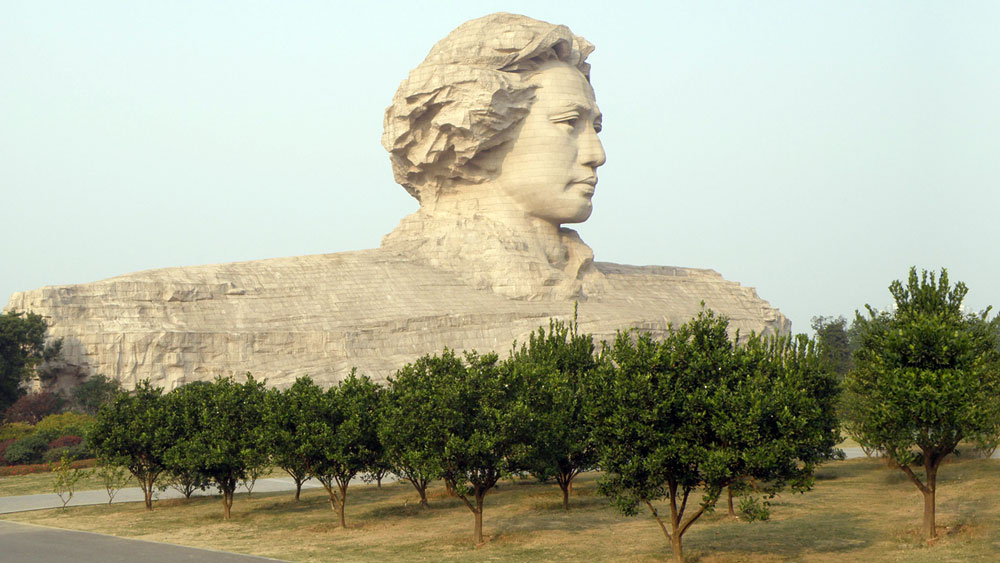

Statue of young Mao Zedong (2009), Juzizhou, Changsha

A.M. : In his Comments on the Society of the Spectacle (1988), Guy Debord wrote: “Reversing a famous maxim of Hegel, I already noted in 1967 that "in a world really inverted, the truth is a moment of the false." The years since then have shown the progress of this principle in each specific domain, without exception.” And further: “The highest point has without doubt been reached by the Chinese bureaucracy's laughable fake of the great statues of the industrial army of the First Emperor, which so many visiting statesmen have been taken to admire in situ. Since one could mock them so cruelly, this thus proves that in all the masses of their advisors, there was not a single individual who knew the history of art, in China or anywhere else.” Does the fake army of the Great Emperor (also considered as the father of the Great Wall, which is authentic, contrary to the terracotta army) embody a symbolic moment of this society of the spectacle?
J.L. : Your remark about the Great Wall is inaccurate. The Great Wall of China, as we know it today, has nothing in common with the one which was built at the time of the First Emperor. It must be said that the latter played only a minor part in its construction; he only had the fortifications of the ancient conquered principalities destroyed and the outer fortifications completed so as to create an unbroken defensive line against the forays of nomadic tribes. His wall was a simple construction of rammed earth surmounted at regular intervals by observation towers where signal fires were lit up to warn the garrisons of a possible attack. This wall made it possible to transmit orders and transport supplies easily and rapidly from one end of the borders to another. The Great Wall as it is today, and whose layout is situated more to the south than the one of the First Emperor, dates back from the Ming Dynasty. It was raised, crowned with watchtowers, crenellation and small pagodas, covered with a facing of freestones so as to obey the aesthetic canons of the Walt Disney studios: it has nothing to do anymore with the long snaky ochre wall which wound through the steppes in ancient times.
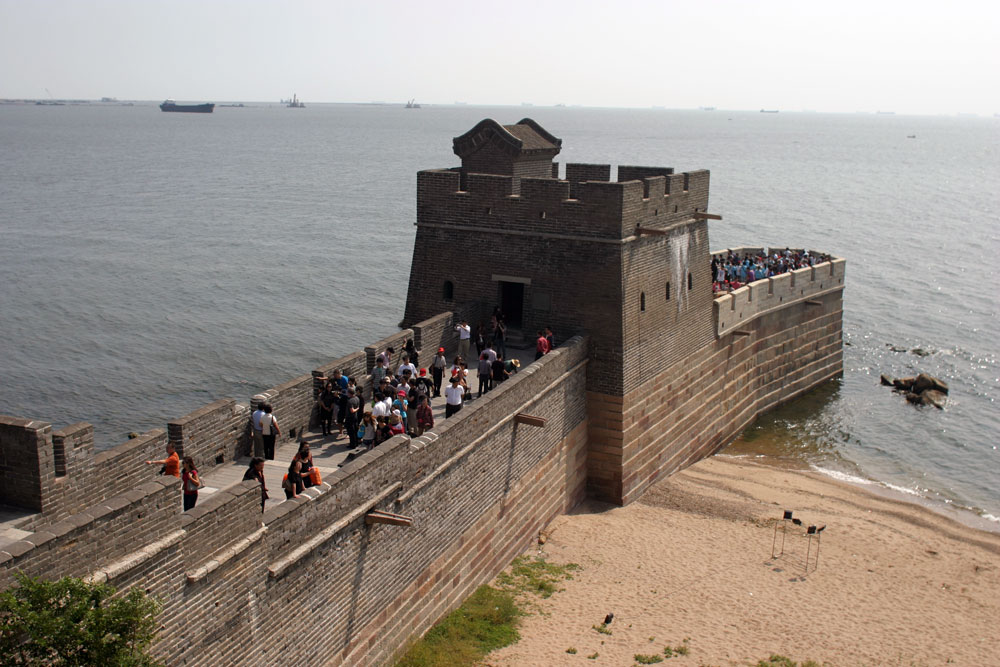
Old Dragon's Head, Great Wall, Bohai Sea
Now to answer your question and go back to your quote from Guy Debord’s Comments on the Society of the Spectacle, in which he reverses Hegel’s maxim. We could also refer to the two symmetrical sentences that frame the portal to the Realm of Illusions and Mirages depicted in the allegorical prologue of the Dream of the Red Chamber by Cao Xueqin: “When falsehood stands for truth, truth likewise becomes false; where naught be made to aught, aught changes into naught.”
As a matter of fact, we have entered the era of the ersatz. The mercantile industrial society has imposed the universal reign of ugliness, so that no one can judge any longer between what is beautiful and ugly, and nowadays the very notion of artistic value has become meaningless. We also live in a world where temporality has been banned. The past, when it survives, can exist only in the form of an imitation, as a fake past reconstructed so as to provide a revised and diluted representation of it which is acceptable for the contemporary human-being, especially if this substitute takes on a gigantic aspect.
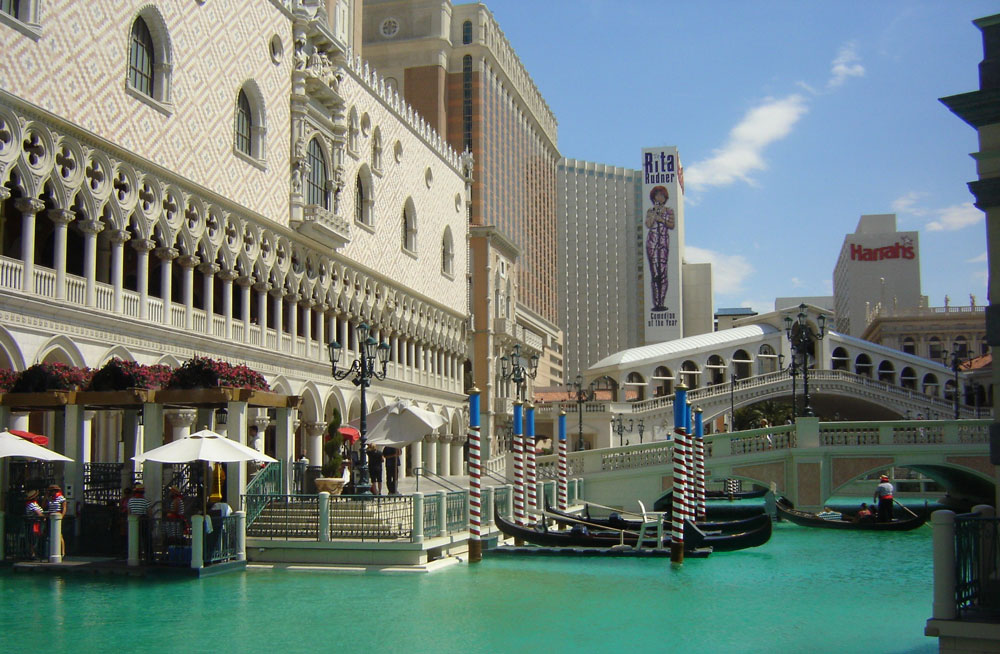
Palazzo Ducale (1999) The Venetian, Hotel, Las Vegas
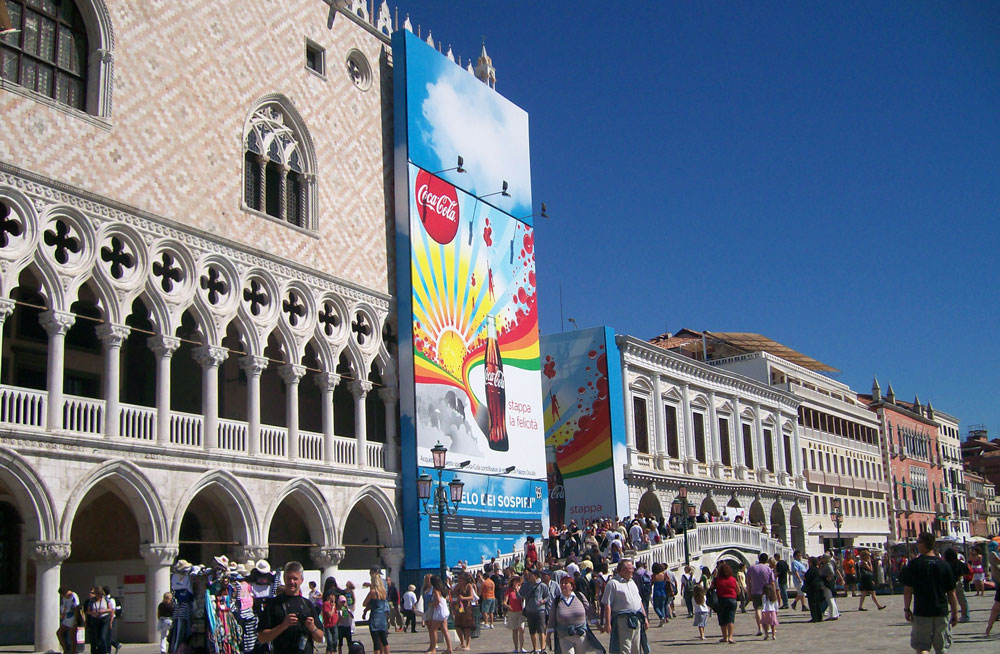
Palazzo Ducale (1340), Venice

A.M. : While we can bring the deception of the terracotta warriors closer to an aesthetic or ideological criticism, with Benjamin or Debord, couldn’t it also be necessary to look in detail at the nature of the hoax in relation to the Chinese notions of strategy, conflict and war? Sun Tzu, in The Art of War, indeed often insists on the necessity of lies, cunning, subterfuges and simulation.
J.L : I don’t know if it would be really pertinent to draw from Sun Tzu’s strategic experience some general laws that could apply to Chinese civilization as a whole. Could the “Middle Empire”, which some consider as the Empire of Signs, be first of all the Empire of the Fake? The Confucians were fiercely hostile to Sun Tzu’s conception of war and to that of the school of Strategists. For them, a war is won through Virtue: the truly wise prince submits peoples by the example of charity and justice that he sets. The rite is more powerful than the strength of weapons and the civilizing influence subjugates the foreign or enemy peoples without encountering any opposition. Using lies is thus out of the question, even in bellicose activities. Furthermore, the Western world is as much a kingdom of mirage and illusion. Ludwig Feuerbach refers to the Christian world, and especially to the Christianity of the late Occident, when he writes in his preface to The Essence of Christianity: “But certainly the present age (…) prefers the sign to the thing signified, the copy to the original, fancy to reality, the appearance to the essence (…) Illusion only is sacred, truth profane. Nay, sacredness is held to be enhanced in proportion as truth decreases and illusion increases, so that the highest degree of illusion comes to be the highest degree of sacredness.” Resorting to falsity is not something new in the West. Falsity has had its letters of nobility, if I may say so, since even before the Middle-Ages. If we wrote a History of Falsification, in the same way that Borges wrote his Universal History of Infamy, the Christian world would be up among the winners.
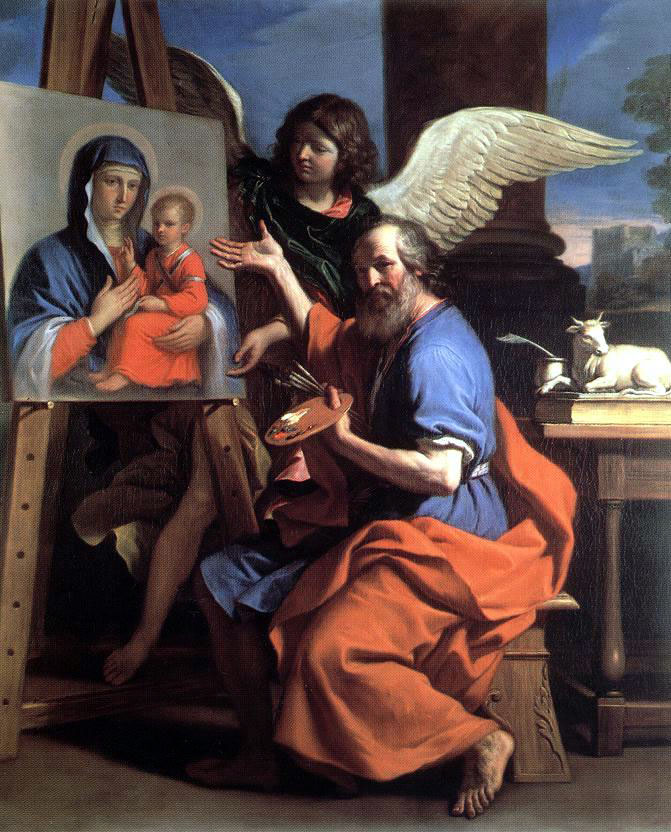
St Luke Displaying a Painting of the Virgin by Guercino (1563)
Nelson-Atkins Museum of Art, Kansas City
The Donation of Constantine, a decree supposedly written by Constantine in which he bequeathed one third of his Empire to the Church to thank Pope Sylvester I who had cured him of leprosy, was a forged document composed in the 8th century to lend some legal justification to the papal ambitions for temporal power. The Protocols of the Elders of Zion, the so-called manifesto of a secret organization made up of Jewish anarchists and bankers who planned to take hold of the levers of power, was revealed to be a fabricated document composed by the secret services of the Tsar at the end of the 19th century, aimed at discrediting the revolutionary leaders and at redirecting popular discontent towards the Jews. The forgers did not even bother to make the document appear authentic, as they had borrowed quotes from the Dialogue in Hell between Machiavelli and Montesquieu, a pamphlet against Napoleon III written by Maurice Joly! In their defense, it should be said that they hardly needed the forgery to look plausible: the European nations, haunted by a deep-rooted anti-Semitism, were all the more ready to believe in any kind of Jewish plot. And after all, what is the Dreyfus case but an accumulation of forgeries, lies and falsifications from the highest authorities of the French army?
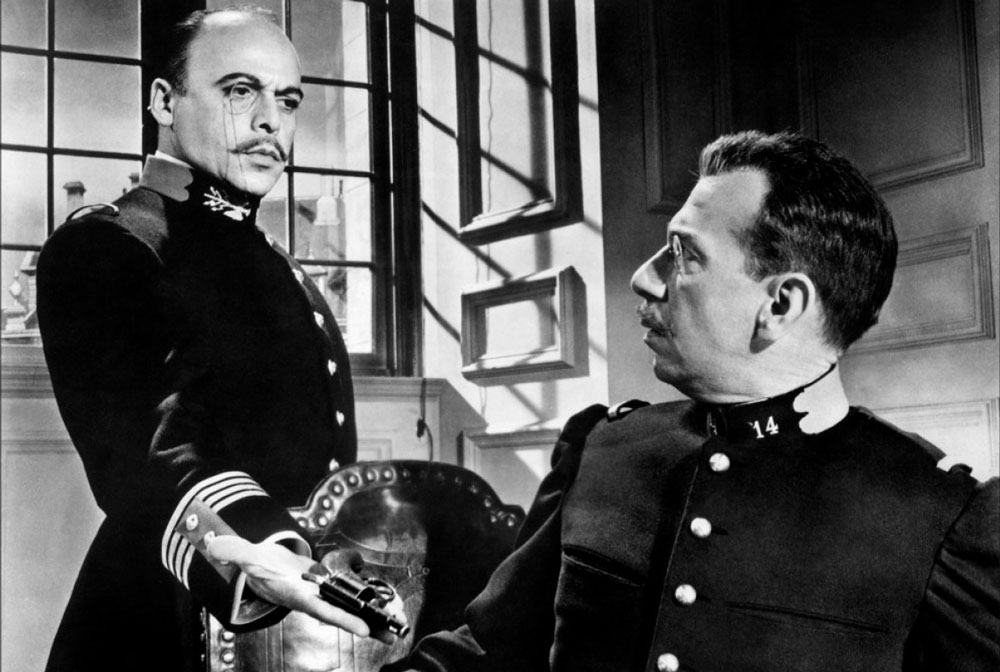
I Accuse, directed by José Ferrer (1957)
Of course, even in the first pages, Sun Tzu declares that “war is based on lies”. But this maxim must be understood within the context of Chinese philosophy and more precisely of its ontology; it should not be seen as a sign of the role of the hoax as specific to Chinese civilization. I think that to understand what it is all about, it is advisable to dwell on the 7th of the 36 stratagems: “Create something from nothing”. This maxim is annotated in the following way by the anonymous compiler: “A lie is never exactly a lie, for a lie aims at creating a reality in the same way as the young yin that, when becoming old yin, turned into old yang.” I will not go into the detail of the hexagrammatic implications of this maxim, but I will provide only the explanation of this obscure utterance with another commentary which is enlightening enough in itself: “Lying consists of nothing more than presenting the non-existent as existent. But a lie cannot last too long without being seen through. Thus the non-existent cannot eternally remain as such. It must give birth to something; thus reality will be born of illusion, what is full will surge from what is empty. The non-existent cannot overcome the enemy; for this to happen it has to release a minimum of being.” To understand this reasoning, it is necessary to know that, contrary to Greek philosophy on which we rely heavily, Chinese philosophy puts the non-existent before the existent. Nothingness, being unconditioned, is endowed with creative power, thus the yin, in this case equal to the absence of being and to vacuity, is endowed with the supreme power of creation. The identification of war to deception has important consequences on a philosophical level. War, as the privileged realm of lies, is necessarily situated at the level of the non-existent. In the sphere of action, cunning is the equivalent of sophism in the sphere of speech. And if we follow Plato in his arguments, the specificity of the sophist being to move into the non-existent, the general will be a master of illusion who manipulates appearance. He is also an expert in the art of nothingness. So the art of strategy amounts to not revealing oneself so as to force the enemy into betraying his own tactics. As soon as one of the adversaries leaves the invisible to appear in the realm of the visible, he lays himself open to attack. All military maneuvers lead to the single effect of seeing through the real situation of one’s adversary, stripping him of his veil of lies and forcing him to appear in his naked truth.

Military decoy : fake inflatable Bell OH-58 Kiowa Helicopter
The true strategist is the one who escapes the world of forms to become the master of sensory realities. This conceptual universe thus differs slightly from that of the fake and of the ersatz; even if the idea is to have someone believe that the real is the false and vice-versa, the difference between the real and the false remains crucial, for the art of strategy consists indeed in being able to make the difference between the real and its false representations. On the contrary, falsification only aims at erasing the distinction between them: the representation takes the place of reality, becoming the only reality which disappears behind its own reflection. In the world of images and shams, reality can only be experienced as an image. Bioy Cesares’s The Invention of Morel provides one of its most perfect allegorical illustrations, though we could assert that Choderlos de Laclos’s Dangerous Liaisons, a novel of manners whose real subject is the birth of bourgeois vulgarity announced by the fetishism of representation, is only a reflection on the paradox of the liar, as Pierre Bayard claims, only because the novel actually deals with the Spectacle, i.e. the impossibility to experience life intensely except through another’s gaze, internalized by the self. In Laclos’s work, the reflection (via the double form of voyeurism and narcissism) already supersedes reality.
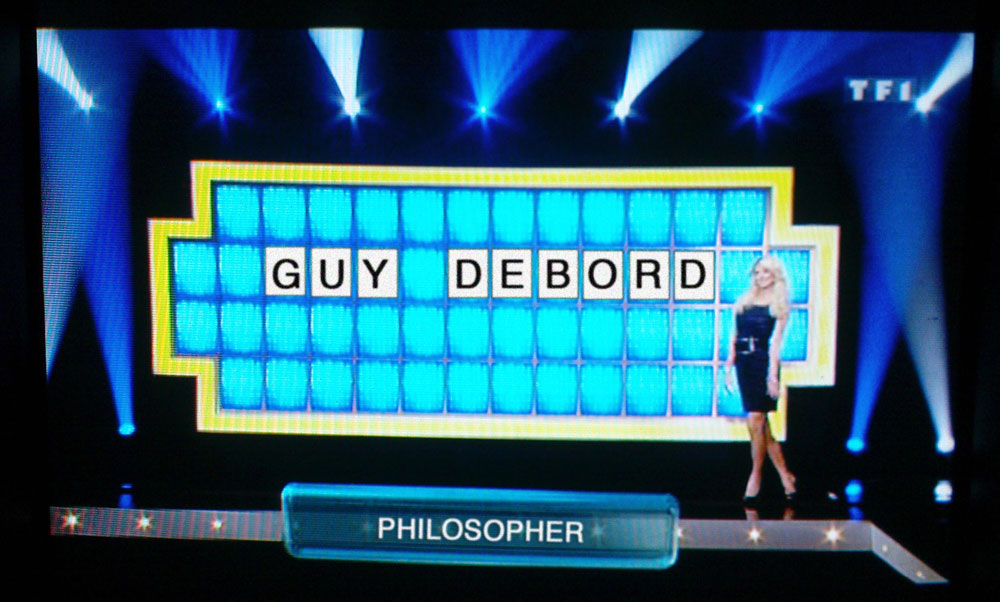
photomontage by Alessandro Mercuri

A.M. : You write: “The late Emperor was buried in the vast tomb studded with stars and scored by shimmering mercury streams.” The historical, literary and nonetheless legendary description of the mausoleum is as artificial as the fake terracotta statues. Does Chinese philosophy indeed create another level of reality, another relationship between myth, thought and history? Couldn’t we imagine this deception as coming straight out of a tale of The Zhuangzi?
J.L. : You say a tale from The Zhuangzi, but it might as well be from a short story by Borges. One of the themes that runs through all his writings and that he modulates in various ways is the idea that representation is more real than reality; or as a representation — i.e. images faithful to reality— which cancels the real or at least has us doubt its reality. Borges is truly haunted by this issue. This is obvious in his poems about mirrors and above all in his metaphysical short stories. Each of them deals with the themes of representation and reflection. Either the imitation becomes a microcosm and thus the universe, in all its richness and complexity, is reduced to one word or even to one letter, or the representation expands monstrously up to the point that it coincides with the world. In this respect, Borges is indeed close to the preoccupations of the Chinese philosopher Zhuangzi. This is particularly blatant in The Circular Ruins, a fantastic tale which narrates the story of a wizard who tries to give reality to a dream and who discovers, once he has realized his project, that he is himself someone else’s dream. It is possible that Borges borrowed the plot of the circular dream to Zhuangzi’s story: waking from a dream in which he was a butterfly, he doesn’t know any more if he’s a philosopher who dreamt he was a butterfly or the dream of a butterfly thinking he is a philosopher.

The Dark Mirror (1946), directed by Robert Siodmak
The reversal caused by the dream reminds us of the one caused by the mirror — this object perhaps being the sensory concretion of the dream. Both provide the prerequisite to all questions concerning the reality of the real. Zhuangzi resorts to the parable of the butterfly’s dream to undermine our peaceful certainties about the existence of reality. Borges knew perfectly well the apologue of Zhuangzi’s butterfly dream. In A New Refutation of Time, he uses it to illustrate the ultimate implications of the idealist theory, that which question the permanence of the self and lead to the negation of time and space.
So I’ve used the notations recorded in the historical chronicles, which provide an imaginary description of the interior of the mausoleum — maybe itself a symbolic and reduced reproduction of the cosmos — to give an allegorical scope to this trivial story. My essay plays on the double representations of imitation: on the one hand Chinese and mythical, on the other hand literary and Borgesian. This aspect is then developed in the second essay of the book, “The little worlds of the dictator”, entirely devoted to the issue of the relation between the exercise of absolute domination and the mastery of the symbolic representations of the real.
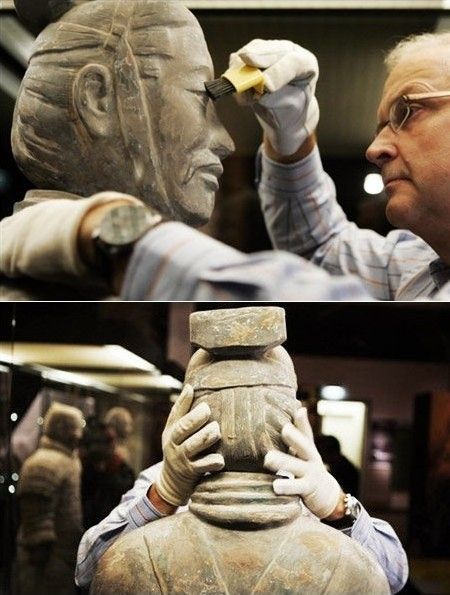
Fake statues of the Mausoleum of Emperor Qin Shi Huang
Museum of Ethnology, Hamburg (2007)

A.M. : The terracotta warriors also question the strategic and economical role of the false in contemporary China. For instance, in 2011, a whole Monegasque show of luxury brands was duplicated in Shanghai. Even more surprising, in 2007, in Germany, the Hamburg's Museum of Ethnology was forced to close down an exhibition of terracotta warriors; after investigating the authenticity of the statues, they were revealed to be fake. The Chinese authorities confirmed the deception and claimed the exhibition had been organized without their authorization. In a world dominated by brands and by the manufacture of material, spiritual or cultural products, could the false be ontologically inseparable from the authentic?
J.L. : Indeed, I feel that Chinese fake products are only the other side of the coin of the industry of luxury goods. It is only because some brands assert the upscale quality of a product for upmarket consumers that there exist alongside them an industry aimed at offering low-priced imitated goods, distinct from the usual junk thanks only to fake designer labels. True luxury cannot be imitated. It is enough to read Balzac’s or Proust’s novels to understand it. The outfits of the Marquise d'Espard, of Odette Swann or above all of the Duchess of Guermantes are works of art which do not need a designer label to be recognized by aesthetes. Yet either they go unnoticed by the crowd, or they are considered shocking or ridiculous. So that we can assert that in the world of brand names, where the sign is substituted with the thing signified, the fake is indivisible from the real only because the real has ceased to exist. As for what happened in the Hamburg’s museum, it is all the more comical that the blamed fake statues were no more fake than the authentic statues which do not exist; for, as we already discussed above, the terracotta foot soldiers and horsemen are a fabrication dating back from the Maoist era.

Jim Lovell, astronaut training for the Apollo 13 mission (1970)

A.M. : It would seem that the larger the lie, the more credible it becomes. The notion of deception could also be linked to those of fiction and plot. The hoax is not only one of the main themes in literature (from Gogol to Cervantes, from Sterne to Musil). In the 19th century, the archeologist Heinrich Schliemann took inspiration from Homer’s texts to transform the myth into history and to discover the Turkish and Greek sites of Troy and Mycenae. Conversely, a Gallup poll (1999) revealed that only 89 % of American people believe that the moon landing truly happened, while 6% are convinced of the contrary and 5% are still unconvinced. With his radio drama The War of the Worlds (1939), his documentary film F for Fake (1973) and his adaptation of Don Quixote (1959), Orson Welles continually staged lies and illusions as the very driving forces behind any human action. In your opinion, would it be pertinent to elaborate a metaphysical or a poetical theory of deception?
J.L. : Probably. We have already mentioned various examples: the terra-cotta warriors, The Protocols of the Elders of Zion, the Dreyfus case, to which we could add the Reichstag fire. But it is perhaps necessary to look at things from a higher perspective. In totalitarian societies such as ours or ancient China, which was an archaic prefiguration of them, Power is distributed throughout the whole social fabric and results in what Marx called the total socialization of society, when everyone is dependent on someone else. The State, which controls every apparatus of the social body, is the master of all its manifestations, even of those which seem to be the most spontaneous. In such a system, everything is part of the State, even the opposition and the dissident groups; even terrorism, far from being the manifestation of some exteriority, is its purest expression: the small groups supposed to threaten law and order do not escape its scrutiny, but serve to justify repressive measures the State decrees, as indeed has been shown by recent current events.
Giorgio Agamben, in his Homo Sacer, thinks he can compare Alain Badiou’s principle of the event with the concept of sovereign exception that he has drawn from the theory of the State elaborated by Carl Schmitt. Applying to politics the categories of membership and inclusion of set theory, Badiou has defined an event as an element whose membership to the situation appears, in relation to the situation, undecidable, and is thus seen by the State as an excrescence, i.e. an anomaly. Consequently, the exception would express the impossibility for a system to have inclusion and membership coincide and to reduce all parts to the unit. But actually, in large state-controlled structures, nothing happens in this way. States know how to reduce all the parts to the unit by creating the events from start to finish. They pretend to be caught unprepared only to throw off balance their adversary, who is distraught by the unpredictability of the chain of events. The State feigns to be startled by the exception only to take hold of the situation again, for it is the State which, at the last resort, decides on the State of exception. The authorities create the troubles which demand emergency measures, so as to remain the master of their own game: it is the best way to restore law and order and to insure a hold on individuals by decreeing coercive measures required by the gravity of the situation. Such tactics, described in a very clear way by Han Fei, the theorist of the absolute and centralized Chinese power of the 3rd century B.C., have been put into practice throughout history by princes and States, in China as well as in the Western world.

Most of the time, the majority of plots against state security hide other plots fomented by the State itself against the safety of the citizens and individual freedom. These issues have been dealt with in my essay entitled “China is a horse and the universe an idea”: via the excellent example of Robert Musil’s The Man without Qualities, I deal with the importance of the distortion of words and things —the notion of lying, to call a spade a spade — in the elaboration of totalitarian systems. Moreover, my novel Le Coup du Hibou tells the story of a plot on a worldwide scale, whose implications go back to the dawn of time; a plot inspired by Chesterton’s famous metaphysical spy novel, The Man Who Was Thursday: A Nightmare.
Yet I must admit that the word “lie” is ambiguous: Ciliga entitled his experience of Stalinian camps « Voyage au pays du mensonge déconcertant » (“Journey to the land of the baffling lie”), while Hesiod calls Pandora, the trap sent by Zeus to Epimetheus under the features of the Woman, a “beautiful lie”. Though it is true that this lie is the result of a conflict of deceptions between the Titan and the Olympian god. Just as Prometheus is an exemplary representation of man as a divine and mortal individual, it would seem that for the Greeks, a lie is consubstantial to mankind. And thus, without illusion, which is the daughter of creative imagination, there would be no art, no science and no literature. And just as Gorgias did, we could well devote ourselves to a praise of lying. All the beauty of The Zhuangzi stems from its myths, its fables and its fantasies which, through their actual unreality, force us to question the unreality of the real and the reality of the unreal.

Military parade, celebrating the 60th anniversary of the People's Republic of China, Beijing, 2009
translated from the French by Blandine Longre and Paul Stubbs
Interview with JEAN LEVI
sinologist, translator, writer, research director at CNRS
by Alessandro Mercuri


Alessandro Mercuri : In the first chapter of your book "China is a Horse and the Universe an Idea" (La Chine est un cheval et l'univers une idée, Editions Maurice Nadeau, 2010), entitled “The Great Emperor and the terra-cotta warriors”, you develop a very unsettling and amazing idea which is at first difficult to believe as your hypothesis completely negates the authenticity of one of the most famous “new wonders of the world”, inscribed on the World Heritage List of the UNESCO in 1987. According to you, the famous terracotta warriors of the Emperor Qin Shi Huang’s mausoleum are fake. It could be one of the most incredible historical forgeries, hoaxes or deceptions. The statues currently exhibited on the archeological site of the mausoleum would not date back from the 3rd century B.C. but from the 1970s. They may not have been made under the reign of the Great Emperor Qin Shi Huang, but under the Great Helmsman, Mao Zedong, at the very end of his reign and of the Cultural Revolution, in 1974, that is to say two years before his death. How have you come up with this surprising hypothesis? What could be the archeological, historical and aesthetical characteristics of these fake figures? Could it be a true Maoist deception?
Jean Levi : In “The Great Emperor and the terracotta warriors” (the first chapter of my book of essays China is a Horse and the Universe an idea) I do maintain the theory that the gigantic terra-cotta statues excavated in the pits surrounding the tumulus of the First Emperor are fake. These famous clay sentinels, which protect the sleep of the despot eternally as is insistently and pompously proclaimed by journalists, do not date back from the 3rd century B.C., the time when the Great Emperor was buried, but from the 20th century, at the end of the Cultural Revolution when the struggle between factions was raging with the “Gang of Four”. As you’ve pointed out, it is nonetheless surprising that this “new wonder of the world”, which has crowds from the four corners of the planet gape with admiration, was inscribed on the World Heritage List without being assessed by international experts as is usually the case when a country officially asks for an artistic or architectural place or property to be listed. The Chinese authorities purely and simply refused the UNESCO experts access to the archeological site, although those same experts apparently did not take much offence as Lingtong’s buried army was added to the list anyway.

Mausoleum of Emperor Qin Shi Huang
I wish to insist on the fact that I’m neither an archeologist nor a specialist of ancient Chinese statuary; I have never had any privileged access to the statues and I have not carried out any physical and chemical laboratory test. My judgment is based purely on stylistic and aesthetic criteria. If we look in detail at the evolution of the manufacturing of funerary terracotta statuary — as a great number of such objects have come down to us — it is obvious that the statues of these warriors are in sharp contrast to everything that preceded and followed them. They stand out because of their gigantic size, their realism and the expressivity of their body language and of their faces. From the Warring States era (5th-3rd centuries B.C.) to the Tang era (7th-9th century A.D.), funerary statuettes are recognizable by their reduced size, their stylization, their hieratic quality and the sobriety of the techniques used. The mingqi — the artifacts made with the specific purpose to accompany the dead in the world beyond — are stylized and refined representations of the real objects; they must not be lifelike copies of reality at all — so as not to confuse the dead with the living. We could put forward the fact that the Great Emperor, who innovated politically by suppressing the feudal system and its fiefs and by establishing the first centralized and bureaucratic government, also tried to break with traditions in the artistic fields in the same way that he had done politically and ideologically.

Mausoleum of Emperor Qin Shi Huang

Statue of Emperor Qin Shi Huang (copy) - product available on China Trade Online - Price Terms : Negotiable
But in fact, all the studies show that the Qin dynasty, although innovative as far as political institutions were concerned, remained conservative in other fields, especially in the artistic ones. Besides, the autocratic reign of Qin Shi Huang was brief — for many years, he was under the tutelage of the Empress dowager and of the Prime Minister Lü Buwei. Now the funerary contents of a grave must be prepared long ahead, and craftsmen, artists and technicians cannot be trained instantaneously to produce a new style. Consequently, it seems rather strange that this terracotta army could have been made in so little time. Moreover, with their monumentality, their realistic aspect and their expressivity, the statues have obvious similarities with the artifacts of socialist realism; all the more bizarre, nothing probably remained of the architectural achievements of the hated emperor after the sacking of the capital of the Qin dynasty by the rebel armies: we are thus entitled to question the authenticity of these statues exhumed from the ground as intact and as clean as a new coin. It is really surprising that not one specialist of this period has expressed doubts or concerns about them. On the contrary, the approval was unanimous.

Mausoleum of Emperor Qin Shi Huang
Apart from the unilateral argument which states that the unanimity of the specialists to consider the terracotta warriors as authentic is the irrefutable proof of their authenticity, the few archeologists I could discuss this issue with resort to two types of argument. The first one is technical: it is about the difficulty that would arise from having armies of modern workers create funerary statues without any leak of their production occurring. Were the workers disposed of? And how? The second objection is political: it refers to the ideological and strategic motives of falsification.

Ronald and Nancy Reagan at the Mausoleum of Emperor Qin Shi Huang (1984)
The first objection does not hold. Nothing is simpler than having life-size terracotta statues manufactured in state workshops while pretending it is an activity of copying, as is done in every museum and archeological site on the planet. Except that they are not copies but fake original works. Nonetheless, given the nature of the regime, there was no difficulty involved for the Beijing authorities — nor would there be any nowadays either — to dispose of a few thousand workers and technicians. As for the instigators of the project, it was in their best interest to keep it secret.

Statues of Chinese soldiers, Jianchuan Museum, picture by Alan Baumler
As for the second objection, which concerns the absurdity and the vanity of the enterprise, it is necessary to remember the ideological context of the Maoist period. The cult of personality had reached its climax. They would have stopped at nothing to glorify the figure of the Great Helmsman; as Mao Zedong tended to increasingly identify himself with the figure of the First Emperor, the discovery around Qin Shi Huang’s mausoleum of a grandiose army of terracotta giants was equivalent to singing an hymn to Mao’s glory and reinforced his grandeur by proxy. This “discovery” may also have met strategic necessities in a balance of power. It was a response to the archeological discovery of Mawangdui. In 1972, in Hunan, a numerous manuscripts written on silk, along with a shroud of jade plaques sewn together with gold threads and other incredibly refined objects, were excavated in a royal tomb dating back from the early Han Dynasty. Among the manuscripts, there were syncretic texts which merged different schools of thought: that of the doctrinarian legalists, Taoism and some aspects of the Confucian doctrine. In Mao’s China, where political struggles were disguised behind the masks of historical figures, the dogmatic adversaries thus saw in this discovery a worrying signal, that of a right-wing shift on the part of the pragmatic wing of the bureaucracy, whose leader was Zhou Enlai. The incredible discovery of the terracotta warriors of the Chinese despotic unifier, which put the spotlight on his prodigious technical and artistic achievements, helped remind everyone of the preeminence of the guiding force of the regime, underlined the necessity to strengthen the dictatorship of the proletariat and showed a determination to take control of things again ideologically.
It goes without saying that nothing is left of these original preoccupations nowadays; how is this for historical irony? The mausoleum hereby asserts the power of China through its patrimonial grandeur. The immemorial and glorious past, to which the terracotta army is testimony, is like a bill drawn on the future. It substantiates the Chinese claim to worldwide hegemony. And naturally, along with the mercantile insanity which has grabbed hold of Chinese society, the terracotta army has become an important source of income and provides a living for an army of parasites from all walks of life.
Besides, the point of my essay was not to dwell on the motives of the Maoist bureaucracy when they devised the extravagant project to fill the mausoleum of the historical double of the Great Helmsman with droves of terracotta figures, but to study the phenomenon of the contemporary masses’ admiration for ugliness, and the impossibility for the modern world to make the difference between reality and its imitations.

Statue of Mao Zedong, Mausoleum of Mao Zedong

Wax statue of Mao Zedong

Mausoleum of Emperor Qin Shi Huang

The Mummy: Tomb of the Dragon Emperor (2008), directed by Rob Cohen

Mausoleum of Emperor Qin Shi Huang

The Mummy: Tomb of the Dragon Emperor (2008), directed by Rob Cohen


The Mummy: Tomb of the Dragon Emperor (2008), directed by Rob Cohen


Statue of young Mao Zedong (2009), Juzizhou, Changsha

A.M. : In his Comments on the Society of the Spectacle (1988), Guy Debord wrote: “Reversing a famous maxim of Hegel, I already noted in 1967 that "in a world really inverted, the truth is a moment of the false." The years since then have shown the progress of this principle in each specific domain, without exception.” And further: “The highest point has without doubt been reached by the Chinese bureaucracy's laughable fake of the great statues of the industrial army of the First Emperor, which so many visiting statesmen have been taken to admire in situ. Since one could mock them so cruelly, this thus proves that in all the masses of their advisors, there was not a single individual who knew the history of art, in China or anywhere else.” Does the fake army of the Great Emperor (also considered as the father of the Great Wall, which is authentic, contrary to the terracotta army) embody a symbolic moment of this society of the spectacle?
J.L. : Your remark about the Great Wall is inaccurate. The Great Wall of China, as we know it today, has nothing in common with the one which was built at the time of the First Emperor. It must be said that the latter played only a minor part in its construction; he only had the fortifications of the ancient conquered principalities destroyed and the outer fortifications completed so as to create an unbroken defensive line against the forays of nomadic tribes. His wall was a simple construction of rammed earth surmounted at regular intervals by observation towers where signal fires were lit up to warn the garrisons of a possible attack. This wall made it possible to transmit orders and transport supplies easily and rapidly from one end of the borders to another. The Great Wall as it is today, and whose layout is situated more to the south than the one of the First Emperor, dates back from the Ming Dynasty. It was raised, crowned with watchtowers, crenellation and small pagodas, covered with a facing of freestones so as to obey the aesthetic canons of the Walt Disney studios: it has nothing to do anymore with the long snaky ochre wall which wound through the steppes in ancient times.

Old Dragon's Head, Great Wall, Bohai Sea
Now to answer your question and go back to your quote from Guy Debord’s Comments on the Society of the Spectacle, in which he reverses Hegel’s maxim. We could also refer to the two symmetrical sentences that frame the portal to the Realm of Illusions and Mirages depicted in the allegorical prologue of the Dream of the Red Chamber by Cao Xueqin: “When falsehood stands for truth, truth likewise becomes false; where naught be made to aught, aught changes into naught.”
As a matter of fact, we have entered the era of the ersatz. The mercantile industrial society has imposed the universal reign of ugliness, so that no one can judge any longer between what is beautiful and ugly, and nowadays the very notion of artistic value has become meaningless. We also live in a world where temporality has been banned. The past, when it survives, can exist only in the form of an imitation, as a fake past reconstructed so as to provide a revised and diluted representation of it which is acceptable for the contemporary human-being, especially if this substitute takes on a gigantic aspect.

Palazzo Ducale (1999) The Venetian, Hotel, Las Vegas

Palazzo Ducale (1340), Venice

A.M. : While we can bring the deception of the terracotta warriors closer to an aesthetic or ideological criticism, with Benjamin or Debord, couldn’t it also be necessary to look in detail at the nature of the hoax in relation to the Chinese notions of strategy, conflict and war? Sun Tzu, in The Art of War, indeed often insists on the necessity of lies, cunning, subterfuges and simulation.
J.L : I don’t know if it would be really pertinent to draw from Sun Tzu’s strategic experience some general laws that could apply to Chinese civilization as a whole. Could the “Middle Empire”, which some consider as the Empire of Signs, be first of all the Empire of the Fake? The Confucians were fiercely hostile to Sun Tzu’s conception of war and to that of the school of Strategists. For them, a war is won through Virtue: the truly wise prince submits peoples by the example of charity and justice that he sets. The rite is more powerful than the strength of weapons and the civilizing influence subjugates the foreign or enemy peoples without encountering any opposition. Using lies is thus out of the question, even in bellicose activities. Furthermore, the Western world is as much a kingdom of mirage and illusion. Ludwig Feuerbach refers to the Christian world, and especially to the Christianity of the late Occident, when he writes in his preface to The Essence of Christianity: “But certainly the present age (…) prefers the sign to the thing signified, the copy to the original, fancy to reality, the appearance to the essence (…) Illusion only is sacred, truth profane. Nay, sacredness is held to be enhanced in proportion as truth decreases and illusion increases, so that the highest degree of illusion comes to be the highest degree of sacredness.” Resorting to falsity is not something new in the West. Falsity has had its letters of nobility, if I may say so, since even before the Middle-Ages. If we wrote a History of Falsification, in the same way that Borges wrote his Universal History of Infamy, the Christian world would be up among the winners.

St Luke Displaying a Painting of the Virgin by Guercino (1563)
Nelson-Atkins Museum of Art, Kansas City
The Donation of Constantine, a decree supposedly written by Constantine in which he bequeathed one third of his Empire to the Church to thank Pope Sylvester I who had cured him of leprosy, was a forged document composed in the 8th century to lend some legal justification to the papal ambitions for temporal power. The Protocols of the Elders of Zion, the so-called manifesto of a secret organization made up of Jewish anarchists and bankers who planned to take hold of the levers of power, was revealed to be a fabricated document composed by the secret services of the Tsar at the end of the 19th century, aimed at discrediting the revolutionary leaders and at redirecting popular discontent towards the Jews. The forgers did not even bother to make the document appear authentic, as they had borrowed quotes from the Dialogue in Hell between Machiavelli and Montesquieu, a pamphlet against Napoleon III written by Maurice Joly! In their defense, it should be said that they hardly needed the forgery to look plausible: the European nations, haunted by a deep-rooted anti-Semitism, were all the more ready to believe in any kind of Jewish plot. And after all, what is the Dreyfus case but an accumulation of forgeries, lies and falsifications from the highest authorities of the French army?

I Accuse, directed by José Ferrer (1957)
Of course, even in the first pages, Sun Tzu declares that “war is based on lies”. But this maxim must be understood within the context of Chinese philosophy and more precisely of its ontology; it should not be seen as a sign of the role of the hoax as specific to Chinese civilization. I think that to understand what it is all about, it is advisable to dwell on the 7th of the 36 stratagems: “Create something from nothing”. This maxim is annotated in the following way by the anonymous compiler: “A lie is never exactly a lie, for a lie aims at creating a reality in the same way as the young yin that, when becoming old yin, turned into old yang.” I will not go into the detail of the hexagrammatic implications of this maxim, but I will provide only the explanation of this obscure utterance with another commentary which is enlightening enough in itself: “Lying consists of nothing more than presenting the non-existent as existent. But a lie cannot last too long without being seen through. Thus the non-existent cannot eternally remain as such. It must give birth to something; thus reality will be born of illusion, what is full will surge from what is empty. The non-existent cannot overcome the enemy; for this to happen it has to release a minimum of being.” To understand this reasoning, it is necessary to know that, contrary to Greek philosophy on which we rely heavily, Chinese philosophy puts the non-existent before the existent. Nothingness, being unconditioned, is endowed with creative power, thus the yin, in this case equal to the absence of being and to vacuity, is endowed with the supreme power of creation. The identification of war to deception has important consequences on a philosophical level. War, as the privileged realm of lies, is necessarily situated at the level of the non-existent. In the sphere of action, cunning is the equivalent of sophism in the sphere of speech. And if we follow Plato in his arguments, the specificity of the sophist being to move into the non-existent, the general will be a master of illusion who manipulates appearance. He is also an expert in the art of nothingness. So the art of strategy amounts to not revealing oneself so as to force the enemy into betraying his own tactics. As soon as one of the adversaries leaves the invisible to appear in the realm of the visible, he lays himself open to attack. All military maneuvers lead to the single effect of seeing through the real situation of one’s adversary, stripping him of his veil of lies and forcing him to appear in his naked truth.

Military decoy : fake inflatable Bell OH-58 Kiowa Helicopter
The true strategist is the one who escapes the world of forms to become the master of sensory realities. This conceptual universe thus differs slightly from that of the fake and of the ersatz; even if the idea is to have someone believe that the real is the false and vice-versa, the difference between the real and the false remains crucial, for the art of strategy consists indeed in being able to make the difference between the real and its false representations. On the contrary, falsification only aims at erasing the distinction between them: the representation takes the place of reality, becoming the only reality which disappears behind its own reflection. In the world of images and shams, reality can only be experienced as an image. Bioy Cesares’s The Invention of Morel provides one of its most perfect allegorical illustrations, though we could assert that Choderlos de Laclos’s Dangerous Liaisons, a novel of manners whose real subject is the birth of bourgeois vulgarity announced by the fetishism of representation, is only a reflection on the paradox of the liar, as Pierre Bayard claims, only because the novel actually deals with the Spectacle, i.e. the impossibility to experience life intensely except through another’s gaze, internalized by the self. In Laclos’s work, the reflection (via the double form of voyeurism and narcissism) already supersedes reality.

photomontage by Alessandro Mercuri

A.M. : You write: “The late Emperor was buried in the vast tomb studded with stars and scored by shimmering mercury streams.” The historical, literary and nonetheless legendary description of the mausoleum is as artificial as the fake terracotta statues. Does Chinese philosophy indeed create another level of reality, another relationship between myth, thought and history? Couldn’t we imagine this deception as coming straight out of a tale of The Zhuangzi?
J.L. : You say a tale from The Zhuangzi, but it might as well be from a short story by Borges. One of the themes that runs through all his writings and that he modulates in various ways is the idea that representation is more real than reality; or as a representation — i.e. images faithful to reality— which cancels the real or at least has us doubt its reality. Borges is truly haunted by this issue. This is obvious in his poems about mirrors and above all in his metaphysical short stories. Each of them deals with the themes of representation and reflection. Either the imitation becomes a microcosm and thus the universe, in all its richness and complexity, is reduced to one word or even to one letter, or the representation expands monstrously up to the point that it coincides with the world. In this respect, Borges is indeed close to the preoccupations of the Chinese philosopher Zhuangzi. This is particularly blatant in The Circular Ruins, a fantastic tale which narrates the story of a wizard who tries to give reality to a dream and who discovers, once he has realized his project, that he is himself someone else’s dream. It is possible that Borges borrowed the plot of the circular dream to Zhuangzi’s story: waking from a dream in which he was a butterfly, he doesn’t know any more if he’s a philosopher who dreamt he was a butterfly or the dream of a butterfly thinking he is a philosopher.

The Dark Mirror (1946), directed by Robert Siodmak
The reversal caused by the dream reminds us of the one caused by the mirror — this object perhaps being the sensory concretion of the dream. Both provide the prerequisite to all questions concerning the reality of the real. Zhuangzi resorts to the parable of the butterfly’s dream to undermine our peaceful certainties about the existence of reality. Borges knew perfectly well the apologue of Zhuangzi’s butterfly dream. In A New Refutation of Time, he uses it to illustrate the ultimate implications of the idealist theory, that which question the permanence of the self and lead to the negation of time and space.
So I’ve used the notations recorded in the historical chronicles, which provide an imaginary description of the interior of the mausoleum — maybe itself a symbolic and reduced reproduction of the cosmos — to give an allegorical scope to this trivial story. My essay plays on the double representations of imitation: on the one hand Chinese and mythical, on the other hand literary and Borgesian. This aspect is then developed in the second essay of the book, “The little worlds of the dictator”, entirely devoted to the issue of the relation between the exercise of absolute domination and the mastery of the symbolic representations of the real.

Fake statues of the Mausoleum of Emperor Qin Shi Huang
Museum of Ethnology, Hamburg (2007)

A.M. : The terracotta warriors also question the strategic and economical role of the false in contemporary China. For instance, in 2011, a whole Monegasque show of luxury brands was duplicated in Shanghai. Even more surprising, in 2007, in Germany, the Hamburg's Museum of Ethnology was forced to close down an exhibition of terracotta warriors; after investigating the authenticity of the statues, they were revealed to be fake. The Chinese authorities confirmed the deception and claimed the exhibition had been organized without their authorization. In a world dominated by brands and by the manufacture of material, spiritual or cultural products, could the false be ontologically inseparable from the authentic?
J.L. : Indeed, I feel that Chinese fake products are only the other side of the coin of the industry of luxury goods. It is only because some brands assert the upscale quality of a product for upmarket consumers that there exist alongside them an industry aimed at offering low-priced imitated goods, distinct from the usual junk thanks only to fake designer labels. True luxury cannot be imitated. It is enough to read Balzac’s or Proust’s novels to understand it. The outfits of the Marquise d'Espard, of Odette Swann or above all of the Duchess of Guermantes are works of art which do not need a designer label to be recognized by aesthetes. Yet either they go unnoticed by the crowd, or they are considered shocking or ridiculous. So that we can assert that in the world of brand names, where the sign is substituted with the thing signified, the fake is indivisible from the real only because the real has ceased to exist. As for what happened in the Hamburg’s museum, it is all the more comical that the blamed fake statues were no more fake than the authentic statues which do not exist; for, as we already discussed above, the terracotta foot soldiers and horsemen are a fabrication dating back from the Maoist era.

Jim Lovell, astronaut training for the Apollo 13 mission (1970)

A.M. : It would seem that the larger the lie, the more credible it becomes. The notion of deception could also be linked to those of fiction and plot. The hoax is not only one of the main themes in literature (from Gogol to Cervantes, from Sterne to Musil). In the 19th century, the archeologist Heinrich Schliemann took inspiration from Homer’s texts to transform the myth into history and to discover the Turkish and Greek sites of Troy and Mycenae. Conversely, a Gallup poll (1999) revealed that only 89 % of American people believe that the moon landing truly happened, while 6% are convinced of the contrary and 5% are still unconvinced. With his radio drama The War of the Worlds (1939), his documentary film F for Fake (1973) and his adaptation of Don Quixote (1959), Orson Welles continually staged lies and illusions as the very driving forces behind any human action. In your opinion, would it be pertinent to elaborate a metaphysical or a poetical theory of deception?
J.L. : Probably. We have already mentioned various examples: the terra-cotta warriors, The Protocols of the Elders of Zion, the Dreyfus case, to which we could add the Reichstag fire. But it is perhaps necessary to look at things from a higher perspective. In totalitarian societies such as ours or ancient China, which was an archaic prefiguration of them, Power is distributed throughout the whole social fabric and results in what Marx called the total socialization of society, when everyone is dependent on someone else. The State, which controls every apparatus of the social body, is the master of all its manifestations, even of those which seem to be the most spontaneous. In such a system, everything is part of the State, even the opposition and the dissident groups; even terrorism, far from being the manifestation of some exteriority, is its purest expression: the small groups supposed to threaten law and order do not escape its scrutiny, but serve to justify repressive measures the State decrees, as indeed has been shown by recent current events.
Giorgio Agamben, in his Homo Sacer, thinks he can compare Alain Badiou’s principle of the event with the concept of sovereign exception that he has drawn from the theory of the State elaborated by Carl Schmitt. Applying to politics the categories of membership and inclusion of set theory, Badiou has defined an event as an element whose membership to the situation appears, in relation to the situation, undecidable, and is thus seen by the State as an excrescence, i.e. an anomaly. Consequently, the exception would express the impossibility for a system to have inclusion and membership coincide and to reduce all parts to the unit. But actually, in large state-controlled structures, nothing happens in this way. States know how to reduce all the parts to the unit by creating the events from start to finish. They pretend to be caught unprepared only to throw off balance their adversary, who is distraught by the unpredictability of the chain of events. The State feigns to be startled by the exception only to take hold of the situation again, for it is the State which, at the last resort, decides on the State of exception. The authorities create the troubles which demand emergency measures, so as to remain the master of their own game: it is the best way to restore law and order and to insure a hold on individuals by decreeing coercive measures required by the gravity of the situation. Such tactics, described in a very clear way by Han Fei, the theorist of the absolute and centralized Chinese power of the 3rd century B.C., have been put into practice throughout history by princes and States, in China as well as in the Western world.

Most of the time, the majority of plots against state security hide other plots fomented by the State itself against the safety of the citizens and individual freedom. These issues have been dealt with in my essay entitled “China is a horse and the universe an idea”: via the excellent example of Robert Musil’s The Man without Qualities, I deal with the importance of the distortion of words and things —the notion of lying, to call a spade a spade — in the elaboration of totalitarian systems. Moreover, my novel Le Coup du Hibou tells the story of a plot on a worldwide scale, whose implications go back to the dawn of time; a plot inspired by Chesterton’s famous metaphysical spy novel, The Man Who Was Thursday: A Nightmare.
Yet I must admit that the word “lie” is ambiguous: Ciliga entitled his experience of Stalinian camps « Voyage au pays du mensonge déconcertant » (“Journey to the land of the baffling lie”), while Hesiod calls Pandora, the trap sent by Zeus to Epimetheus under the features of the Woman, a “beautiful lie”. Though it is true that this lie is the result of a conflict of deceptions between the Titan and the Olympian god. Just as Prometheus is an exemplary representation of man as a divine and mortal individual, it would seem that for the Greeks, a lie is consubstantial to mankind. And thus, without illusion, which is the daughter of creative imagination, there would be no art, no science and no literature. And just as Gorgias did, we could well devote ourselves to a praise of lying. All the beauty of The Zhuangzi stems from its myths, its fables and its fantasies which, through their actual unreality, force us to question the unreality of the real and the reality of the unreal.

Military parade, celebrating the 60th anniversary of the People's Republic of China, Beijing, 2009
translated from the French by Blandine Longre and Paul Stubbs
TAGS : Jean Levi, La Chine est un cheval et l'univers une idée, China is a Horse and the Universe an Idea sinologist, Maurice Nadeau, Emperor Qin Shi Huang, Terracotta Army, fake, terra-cotta warriors of the mausoleum of Qin Shi Huang, Mao Zedong, Cultural Revolution, Great Helmsman, China, communism, revolution, archeological site, UNESCO, statue, imposture, falsification, deception, illusion, lie, war, cunning, simulation, artifice, artifact, Tang, Qin, Ming, mingqi, Lü Buwei, ideology, strategy, Mawangdui, Hunan, Taoism, Yin, Yang, worldwide hegemony, philosophy, Commentaires sur la société du spectacle, Comments on the Society of the Spectacle, Society of the Spectacle, Guy Debord, Hegel, Great Wall, Walt Disney, Disneyland, Dream of the Red Chamber, Cao Xueqin, ersatz, Art of War, Walter Banjamin, Sun Tzu, Confucians, Confucius, Ludwig Feuerbach, Essence of Christianity, Donation of Constantine, Jorge Luis Borges, Universal History of Infamy, The Protocols of the Elders of Zion, Dialogue in Hell between Machiavelli and Montesquieu, Maurice Joly, Napoléon III, Dreyfus case, The Invention of Morel, Bioy Casares, Dangerous Liaisons, Choderlos de Laclos, Zhuangzi, The Circular Ruins, Hamburg's Museum of Ethnology, Marcel Proust, Marquise d’Espart, Odette Swann, Duchess of Guermantes, Heinrich Schliemann, Apollo 11, Apollo 13, Orson Welles, Reichstag fire, Giorgio Agamben, Homo Sacer, Carl Schmitt, Alain Badiou, Han Fei, conspiracy, The Man without Qualities, Robert Musil, Le Coup du Hibou, Chesterton, The Man Who Was Thursday: A Nightmare
NEXT POST >>










